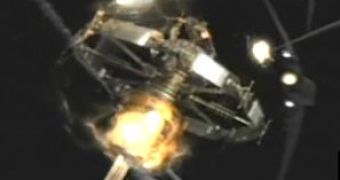Two months ago, China's surprising launch of a missile that hit one of its own retired satellites, blasting the spacecraft into thousands of shards of space junk sparked an international outcry over anti-satellite weaponry.
The U.S. perceived the test not only as proof of China's increasing military capabilities and ambitions, but also as a possible threat to its dominance in military space.
U.S. Navy Capt. James Graybeal, spokesman for the U.S. Strategic Command, said at the time that the military has no ongoing missile or laser-based anti-satellite weapons research.
Instead, they adopted another strategy to prevent the Chinese, or anyone else, for that matter, from doing anything to affect or destroy American satellites.
Rather than a kinetic approach, say officials and experts, the United States has adopted a method that relies on spy satellites' most vulnerable aspect: the need for constant housekeeping from the ground.
To maintain satellite orbits, particularly low Earth orbits, controllers on the ground must send their satellites a constant barrage of signals from ground stations around the world. For example, the United States maintains the Satellite Control Network, a string of eight tracking stations in places as remote as Thule Air Base on Greenland, and Diego Garcia in the Indian Ocean.
By interfering with those signals - called telemetry, tracking and control signals - the United States can put satellites out of commission for critical periods of time or send them spiraling out of control. Intelligence experts call the strategy "electronic negation" or "intrusion."
It's logical, indeed, since laser, missiles or space mines would be easily detected, and could start an arms race in space or even a spatial cold war.
So, "plausible deniability" is the key, and using signals intelligence and intrusion is far subtler, and thus more difficult for the victim to detect.
In fact, the Russian first experimented with anti-satellite weaponry in the 1970s, when they successfully turned off a U.S. Maritime communications satellite, while it was outside the range of tracking stations in the continental United States, and then turned it on again, once it came back into range, causing fears of Soviet space dominance.
William E. Burrows, a journalism professor at New York University who is also the author of "Deep Black," a book on spy satellites applications, once said that "The best ASAT (anti-satellite device) is not a weapon that detonates next to an enemy satellite, instead, it would be a signal that would tell the satellite to take the rest of the afternoon off."

 14 DAY TRIAL //
14 DAY TRIAL //